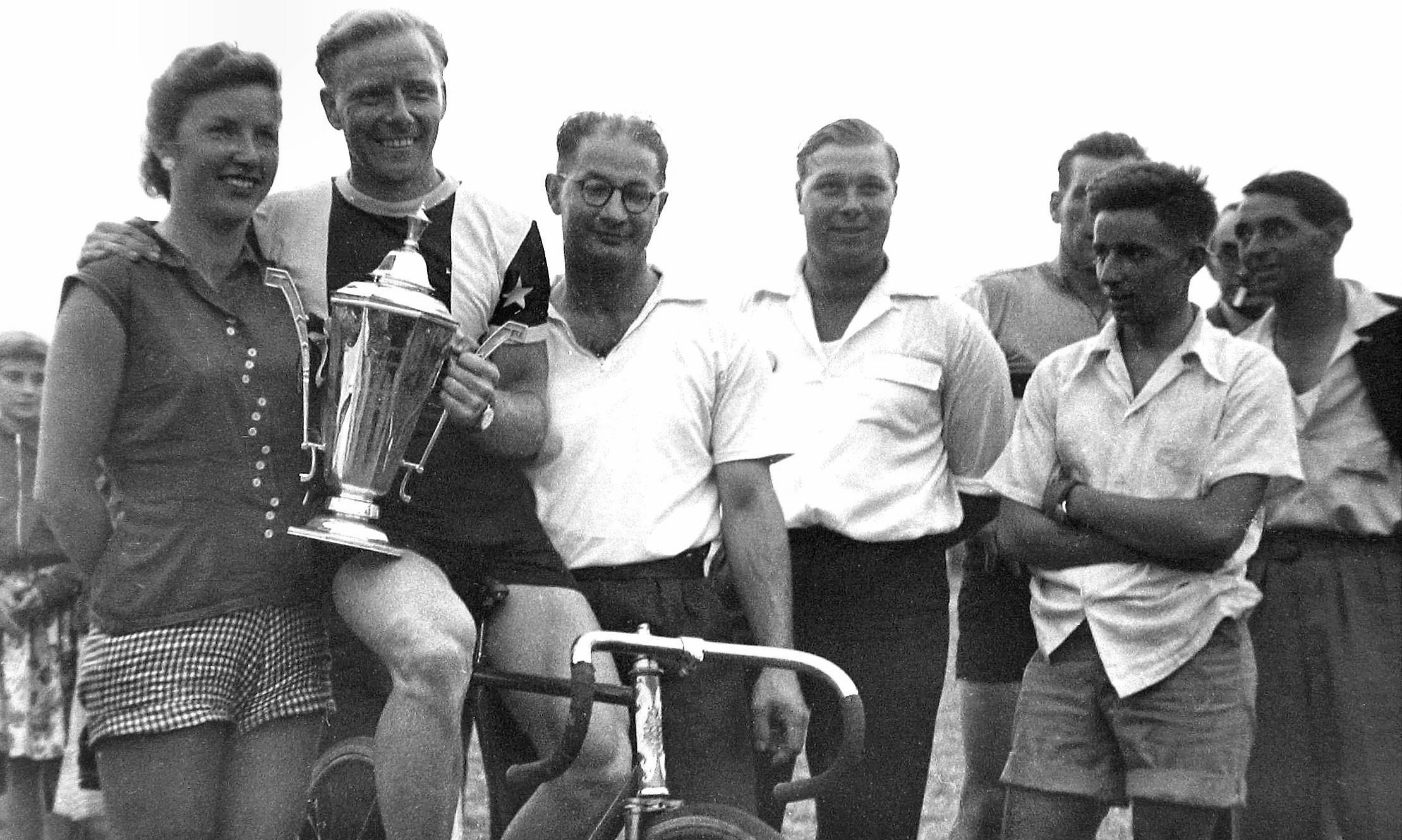Cycling with the Actonia
Posted: Friday 21st August 2020
I was amazed to find this picture of myself racing on the H E Green page in Classic Frame Builders on this site. The event was a time-trial organised by the Actonia and was on the Amersham Road. I got in touch with the webmaster and agreed to do this piece for the Reminiscences page:
I never set out to get involved with cycling in a big way: when I was about fourteen I didn’t own a bike of any description let alone a racing bike and nobody in my family knew anything about cycling as a sport. My one and only sister, who is ten years older than me, married a man from Wandsworth and moved into a downstairs flat at 355 York Road, right next door to ‘Fred Dean’s’ shop. I remember visiting her on Saturday mornings and seeing an array of the most fantastic looking bikes leaning up against Fred’s window, I was smitten; I wanted to be part of this sport.
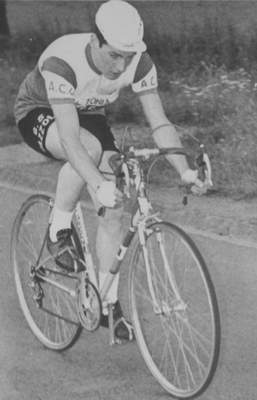
I began buying the Cycling & Mopeds magazine and gleaned all the information I could about bikes and the riders of the day. I seem to remember Alf Engers (time trials), Clyde Rimple (a black rider, mainly on the track) and a guy who I believe was in the Army and always seemed to set the record for the Bath Road 100, I think his name was Roger Wilkins or Wilkinson.
I managed to get hold of a half-decent frame and, bit by bit, built my own racing bike, not too good to look at but it worked and it kept my interest up for better things to come. Things did get better when I became fifteen. I started work as an apprentice printer 27 December 1959 at a print shop in Hammersmith called ‘Chambons’. I also had an early morning paper round and a Saturday job in a greengrocers. Financially I was doing quite well and had thoughts of buying a proper racing bike. I got lots of brochures and the bike that I was drawn to most was the ‘Dawes Double Blue’ but unfortunately the price was still beyond my means.
As I lived in Hammersmith I knew about ‘Doc Green’s’ shop but had never been inside. Being a bit shy I always found these bike shops rather intimidating to the new boy. The shop always seemed to have at least 4 or 5 racing cyclists inside and talking in a language that an outsider wouldn’t understand. Things all seemed to be ’Gen’ or about riders getting the ‘Bonk’. I didn’t know what either meant. Either that or they were discussing times from the previous weekend’s time trials.
After a while I summoned up the courage to go inside and buy something quite small, probably a puncture outfit. I remember bike frames hanging on hooks on the ceiling at different stages of completion and most of all I remember ‘Doc’ speaking to me. He must have met lots of young lads in his time. I expect we all had the same look of awe on our faces when we came face to face for the first time with the gears, hubs, saddles and all the other stuff we had read and dreamt about.
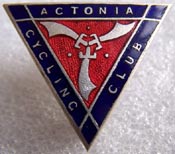
After that first time I became a regular in ‘Doc’s’ shop and got to know the indigenous cycling population quite well. I picked up on the jargon and also the price a good bike would cost, still too much for me! There was also another nice guy who worked in the shop. (his name escapes me) who would make all the wheels and do other bike repairs while ‘Doc’ worked out the back on the frames. Eventually one of the lads invited me to join his cycling club as at the time they were looking for new members. The club was ‘Actonia CC’ and we met weekly in a school in Acton High Street.
I guess I joined the Actonia in late 1960. The clubhouse was a self contained brick building which sat in the playground of an old school tucked away in a cul-de-sac opposite Acton Town Hall. The club made new members very welcome and as I already knew some of the lads from ‘Doc’ Greens it didn’t take me long to feel at home. I soon found out that nearly everybody had a title; there was a Time Trial Secretary, Road Race Secretary, Social Secretary, Sweepstake Secretary, the list was endless, it was more difficult not to get a secretarial title than to get one! The top job was held by Joe Deacon who was Club Secretary at that time and a very nice man to boot.
The membership age range started with the juniors of about 15/16 years old and right through to the veterans, some of them well into their sixties, but fit as fiddles. There were a quite a few husband and wife memberships, the wives, apart from joining in on the occasional Sunday Club run, would make teas and serve cakes on club nights, run the raffle, make sure your ‘subs’ were up to date, try and coerce you into writing for the club magazine and kept any sick members informed of forthcoming events and club business, in short they were very efficient ‘Mother Hens’.
There I was, a member of a cycling club and still no proper bike to ride. My hand-built bike was continuously being upgraded but it wasn’t the bike that I wanted. I was in the back of the shop one day watching ‘Doc’ build a frame when he asked me if I’d ever thought of having one of his hand-built bikes. I told him I’d love one but the cost was way beyond my means. He stopped what he was doing and said that if I could have a hand built-bike did I know what components I wanted on it etc, of course I did, I’d dreamt of nothing else for months.
After doing the sums the bike I wanted would cost me about £200-00, an enormous amount of money in those days and well out of my league. Then ‘Doc’ made me one of the most generous propositions I have ever had, he would build me my bike ‘on the book’. I promised to pay him at least £3-00 per week and when I’d accrued £20-00 he would start building the frame (which I remember costing £22-10s including the spraying and partially chromed front and back forks). ‘Doc’ kept his word and I kept mine, my bike was made in 1961/2 and being raced long before I’d finished paying for it, but finish the payments I did!
Sadly, after about eighteen months the bike was stolen. Myself and a few club mates had cycled over to Herne Hill to watch the annual Easter track racing. Top of the bill were Tommy Simpson and Rik Van Looy. When it was all over we went to where we’d chained our bikes up and mine was missing, the chain, (in retrospect, not very substantial), had been cut and was laying on the floor. Fortunately the bike was insured and after about a six week period the insurance company paid me out in full. I ordered a replacement bike from ‘Doc’, which was more or less the same as the stolen one but with a few modifications. The second bike is the one I am pictured riding (above and below).
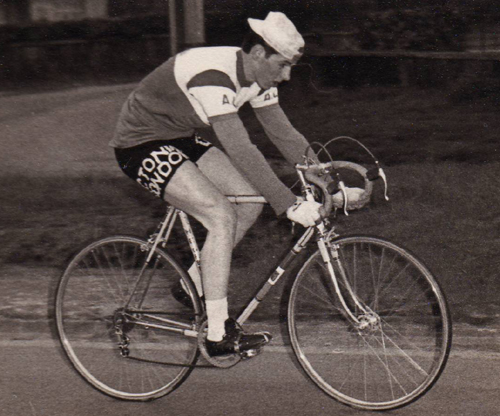
Specifications:
I’m having a job remembering the all ‘specs’ for my bike but I’ll do my best. In those days frame sizes were measured in inches, mine was 23″ from bottom bracket to the top of the top tube. Everything that Campagnolo made at that time was on my bike:
- Gears (front & back)
- Quick release wheel hubs (large flange)
Cotterless bottom bracket set - Head set
- Seat pillar
- Chain set (54t outer ring 46t inner ring)
Pedals - Handlebar-end gear changers.
- The saddle was a butchered ‘Brooks B47’; brakes were ‘Mafac Centre pull’ and a Cinelli handlebar stem. I can’t remember the make of the handlebars but they were very popular at the time.
The Chequers Chase – 1962
I had two sets of wheels, one with lightweight road tyres and the other with ‘Tubs’, I think the wheels were Mavic, but again, not sure. A few of the Actonia riders would go to Ghent, in Belgium, every year and try their luck at racing against the continentals. One of them, Johnny Willis, would always bring back (if ordered and paid for up front), sets of chrome wheel spokes. Quite a few of us had them and when the wheels were built they really did look good but unfortunately didn’t make you go any faster.
Ten gears was the maximum you could have back then and I remember studying the back page of W.F. ‘Sandy’ Holdsworth’s little book Bike-Riders ‘Aids’ which had a chart of all the gear ratios and how far one pedal stroke would take you. My 5-speed block went 13-15-17-20-24 and many an hour was spent discussing the pros and cons of various configurations. Of course the individual sprockets could be removed and changed depending on the type of terrain you were due to race over.
By the way, the Holdsworth’s book came out annually (see copy right) and was like a bible to all us lads in West London; it had all the latest cycling stuff in it. It didn’t matter how good your bike was you could always find something else that you wanted, in it. I wore Fausto Coppi racing shoes with cleats (put on by ‘Doc’) and I think that’s about it.

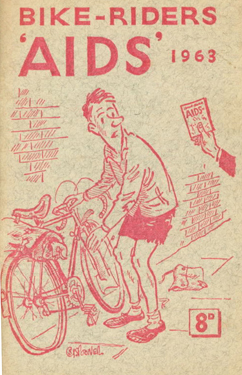
Memories
The photo (as already mentioned) was taken by Bryan Gwyther who was a member of the Actonia CC. Not only was Bryan our club photographer but would attend as many races as he could (cycling to all of them), just to take his beloved photos. Bryan had a speech impediment but it never stopped him talking and we did get a fair bit of fun teasing him. He always saw the funny side of things and had a very infectious laugh. Not only was Bryan a keen and good photographer he also had a photographic memory. I mentioned at the beginning that I was in the print trade. Many years later I was working at the ‘Radio Times’ in Park Royal. It was just before Christmas and they were taking some casual staff on and Bryan was one of them. He must have been there a couple of days when I heard his voice, I went over to say hello and he recognised me straight away. We had a little chat but his voice was much worse than before and it was hard to understand what he was saying. The next day he came and found me and took me to the canteen where he showed me hundreds of photos he had taken over the years and took great delight in pointing out the ones that I was in.
Bryan stayed at the ‘Radio Times’ for quite a few months but as he was a casual he had eventually to leave. I heard sometime later from a mutual friend that Bryan was dead. He was on his bike and had been run over and killed by a lorry. I wondered then if Bryan’s speech problem was really a hearing problem that had worsened over the years. Maybe he didn’t hear the lorry? Another of Bryan’s photographs below:
The photo at the top of the page was taken on the club’s time trial course on the Amersham Road. It was always a very early start as we had to be finished and off the road by 8-00am. We used the course for 10 and 25 mile time trials.
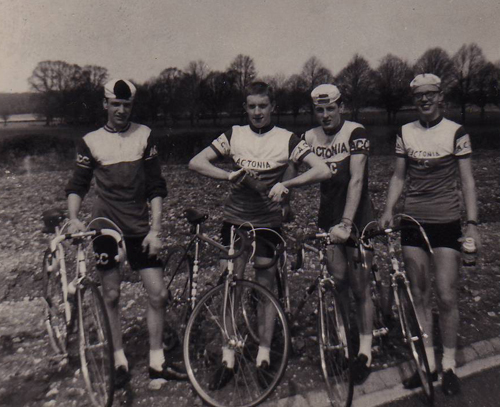
A few more thoughts
I had to pack up racing cycling due to a bad injury on my left knee in 1965. After a few years of playing guitar in different bands I went back to fishing which I had neglected for some time. It came as a surprise to see one of my cycling heroes from the old days, Alf Engers, was now a top angler; you can’t keep some people down.
When I was doing my apprenticeship at ‘Chambons’ I became friends with another racing cyclist who worked in the office. His name was Colin Spearman and he rode for the Archer Road Club. Colin was a very fine rider both on track and road and in the summer would go to the continent for two weeks to compete in road races. Colin did a lot of his training on the track at Paddington Rec and was fit as a fiddle and built like a beanpole. I lost touch with him when I moved jobs only to ‘find’ him again when I got computerised and joined up with the fledgling ‘Friends Re-United’. We spoke on the phone quite often and exchanged e-mails almost daily. Once we went to a cycling film and talk show which was held annually at the Riverside studios in Hammersmith and hosted by a man named Charlie Woods, who, incidentally, wrote a book about cycling called BIKIE. Well worth a read if you haven’t already read it.
Colin still looked young and fit as ever and still cycled everywhere, so it came as a great shock when his daughter rang one day to say that Colin had had an enormous heart attack and nothing could be done to save him.
In 1962 I wrote the following for our works magazine:
“I would like to congratulate Colin Spearman on winning the West London Cycling Championship for 1962. This is the second time he has won the award, the first being 1958 at the age of 17. To win this championship he recorded the fastest time over distances of 25, 50 and 100 miles plus the 12-hour time-trial. To win this championship is no easy task as there are 40+ cycling clubs, all with top class riders. The 12-hour race entails riding around a circuit for 12 hours, each rider being sent off at minute intervals. The mileage is recorded at the end of their 12-hour stint.
Colin had an aggregate speed of over 22mph – his times are as follows:
- 25-miles in 1h 1m 18s
- 50-miles in 2h 7m 10s
- 100-miles in 4h 30m 50s
- 12-hours completed covering 235¼ miles
Colin who works in our office, at the age of 22 has not only made a name for himself in England, but also in Holland where he races in the summer.
Another two names of very good cyclists come to mind. I’d competed against them on many occasions and they just seemed to win everything. They raced for different clubs and their names were Keith Mernickle and Lindsey O’Brien.
Actonia Club Runs
We would meet every Sunday at 7-00am outside Acton Town Tube Station, if you hadn’t arrived by 7-30am they would leave without you.
There was a pecking order in the formation and behaviour of the club run. The more senior members would take up the front positions with the younger and newer members towards the rear. We would set off at a leisurely pace and because of the absence of cars in the early ‘60’s it was quite possible to ride, most of the time, two abreast. The first stop would be at a ‘Halfway House’. All our club runs, irrespective of direction or destination would stop at a ‘Halfway House’ somewhere along the way. ‘Halfway Houses’ were cafes/greasy spoons that would open their doors early on Sundays to accommodate the cycling fraternity, and, of course, any other passing travellers.
After our break it was back on the bikes and onwards to our chosen venue. After cycling a few miles there would be a noticeable speeding up of the group which culminated with one or two of the Senior Racing Team members going off the front and making a break for our eventual destination. Anyone capable jumped onto a wheel and from then on in it was heads down and race like mad to wherever we were headed. This weekly ritual had the nickname of ‘smash and thrash’ and what a learning curve it was for us juniors. If you managed to stay with the leading bunch you’d be expected to do your bit, and if you went off the back, so be it. They took no prisoners and you soon learnt your racing skills.
The older members were only too happy to see us go; they could then get on with their leisurely club run.
It didn’t really matter if you arrived first or last, everybody knew where to meet up and once we were rested and all accounted for we would repeat the process on the ride back home. As we were based in West London many of the club trips were to the South Coast, Brighton, Bognor, Littlehampton, Eastbourne etc. One of the ‘nicer’ points of our club runs was that any trip to the South Coast involved going over the North and South Downs a couple of times. I was not a natural hill climber, I preferred less undulating roads, so I never came to fully appreciate the joys of hauling my carcass up some of Southern England’s most beautiful one-in-fours, such as Bury or Reigate Hills, to name but two.
One memory that I will always have was the camaraderie shown by other cycling clubs as they passed by in the opposite direction. There was always a wave or a shout of ‘Good morning’ or ‘where’re you off to’? Everyone was so friendly in those days; I expect it was the kindred spirits thing.
I’m now in my mid-sixties and one thing I still find unbelievable, and I expect this has happened to many an ex-cyclist, is when I go out and about in my car to somewhere on the South Coast I find it hard to believe that I used to think nothing of cycling there and back and probably did it quicker than it takes now by car!
I never knew or met ‘Baz’ Wells, he was a member of the Actonia C.C. a few years before I joined and to all accounts a very keen and promising racing cyclist. The ‘Milk Race’, (the old Tour of Britain), was at the time organised by local cycle shop owner ‘Chas’ Messenger. Marshals were needed for the race and ‘Baz’ was one of the volunteers. Sadly he was knocked down and killed by one of the race’s following vehicles. Every year the Actonia C.C. held the ‘Baz’ Wells Memorial Road Race which was always well attended.
Actonia Socials
One thing all the members looked forward to, apart from the racing and time trials, was the annual dinner and dance. Once you had got to know everybody they became your extended family and always went out of their way to encourage us newer lads. The dinner and dance was no exception as this was the night all the cups, medals and prizes were given out and nobody was left out.
It was difficult, if not nigh on impossible, to come away without some award or other. The younger and newer members always received something to mark their progress however vacuously the award was entitled, things along the lines of, ‘Best Newcomer’ or ‘Best up and coming’ or even ‘Best time for a 15 year old. It was highly likely that, failing everything else, I might have won the ‘Youngest and newest member who rode an H.E.Green racing bike and lived in Hammersmith’ award, although I expect the engraver might have had something to say about that!
Training.
Training
Compared with today’s strict scientific dietary and training regimes the methods used by racing cyclists back in the early 60’s and before, were positively Neanderthal.
Our training in the summer months consisted of the Sunday club run, (if you weren’t competing elsewhere), and the Tuesday and Thursday evening training runs. For the two evening runs we would all meet outside the Kew Bridge café at 7-00pm and leave about 7-30. As far as I know these were completely unorganised affairs, anybody from any club was welcome, the more the merrier.
Bagshot
On Tuesdays we would head out west on the London Road, through Hounslow, past London Airport, (as Heathrow was then called) and on to Staines. Once over Staines Bridge things would start in earnest with riders jockeying for position as we approached Egham Hill. Once over the hill it was a more or less straight road passing Virginia Water, Sunning Dale and Sunning Hill and on to Bagshot which was the half way mark.
The rules, if you could call them rules, were simple, it was first past the post, there were no prizes to be had, it was all for glory. Once the bunch had reached Bagshot it turned around and raced back to the Kew Bridge café, it was a 45mile round trip and the first man back was deemed the winner. The total journey time was about 2½ hours and we went in all weathers, so it was a pretty hectic workout.
Richmond Park
The Thursday night training run was either to Richmond Park or Box Hill. For those who don’t know, Richmond Park is an enormous Royal park which is completely surrounded by a high wall. Its original use was as a hunting ground for the Royal Kings going back to the 1630’s and to this day still contains large herds of Red and Fallow deer. Inside its walls the park is circumnavigated by a road which we estimated to be about seven miles per circuit, the aim of the training run was to complete three circuits in road race conditions. It doesn’t sound too difficult but just one circuit was enough for some. Richmond Park has the highest point in the London area and this was echoed in the very punishing course with plenty of hills, some short and steep, others long and gruelling as well as some very fast stretches. As with the Tuesday runs there were no rules, we would all set off from the Kew Bridge Café at a leisurely pace and complete the five mile journey to the Richmond gate entrance of the park, once inside things began to speed up as the bunch transformed itself into a Pelaton with serious racing in mind.
One thing that springs to mind, and still makes me smile, is that cars and motorbikes were also allowed to use the road, it wasn’t just for cyclists. In those days the speed limit in the park was 15mph and being a Royal park it was quite heavily policed. We were constantly being reported to the police by irate and law abiding motorists who’d reported us for passing them ‘at speeds in excess of 15mph’. Quite often a squad car would pull us up on the side of the road and give us a lecture about observing the speed limit.
We all pleaded ignorant as we had no way of knowing what speed we were going, the Police seemed to work on the basis of that if you overtook a car you were going too fast, but nothing ever came of it. Apart from that Richmond Park was, and still is, an excellent venue for preparing you for the road racing season, the vagaries of the undulating circuit will certainly sort out the men from the boys.
Box Hill
Box Hill is in Surrey and part of the North Downs, it is also very steep. I’ve heard quite a few different reasons why it is named Box Hill, one was that years ago it was covered in Box Trees another was of some local ritual to do with Boxing Day, who knows? We never went there too often on our training runs as you had to ride about twenty miles just to get there but once there you knew you were going to suffer, it was a hill climbers dream.
The journey from Kew Bridge would be very orderly, more like a casual club run, and it stayed that way for some miles. We’d pass Chessington Zoo, go through Leatherhead and head for Dorking. Once on the A24, (the Dorking road), the pace would lift a bit as the climbers got to the front. At the village of Mickleham sign we would swing left, go through the tiny village and on to the end of the lane. A quick left turn followed by a right found you on the approach road to Box Hill. A quick look up would confirm that you’d arrived and the pain was due to start.
As daft as it sounds I found the flat approach road the hardest bit of the climb, it was quite a long road and although it looked flat it was in fact a very subtle gradient which seemed to go on for ever, I got the feeling that any strength I had left was being sapped away but was probably more to do with the fear of things to come. After this you hit the climb proper; a fairly narrow and uneven road up a one-in four gradient with four or five hairpin bends, which in themselves had to be one-in-three’s. Box Hill was also a popular venue for motor bikers who liked to test their machines out on the ‘Zig-Zag’ as the climb was known because of its hairpin bends. It could be quite daunting, struggling around a hairpin bend on the wrong side of the road only to find a great big hairy ‘Biker’ coming towards you at a great rate of knots. Once at the top we would re-group, tell our individual stories on how we suffered and very thankfully make our way home.
Diets and Rituals
As mentioned previously, controlled and scientifically based diets for sportsmen and women in the 1960’s were, as far as I knew, virtually non-existent. They may, to some degree, have been available to top professional riders but amateurs knew very little about them. Myself and the rest of the Actonia junior team were always looking for ways to be better ‘racers’ and were always willing to try the latest ‘in food’ that was ‘guaranteed’ to make you go faster, climb quicker or last longer. Many were tried and most failed, we did have some foodstuffs that we religiously stuck with and if you believed in them then they had to work—didn’t they?
One that springs to mind was a wheat germ product called ‘Bemax’. I’d known the pungent smell of Bemax since the day I was born as their factory was situated on the River Thames at Hammersmith, not too far from where I lived. When they went into a certain part of the production process the aroma would permeate the surrounding area for miles, little did I know that a few years later I would be eating the stuff—YUK.
For the uninitiated Bemax looked like finely crushed up Weetabix only lighter in colour. The best way to eat it was to sprinkle copious amounts of it onto your chosen breakfast cereal, cover it with enough milk and sugar to kill the taste, hold your nose and eat the offending mess as quickly as possible. It was supposed to be an essential part of any sports person’s diet; whether it did any good is anyone’s guess but I stuck with it until I had to retire from racing.
Bemax was only one part of my healthy diet, the other was steak. My Dad swore by steak. He had been a professional boxer before the war and as far as he was concerned you wouldn’t get anywhere in any sport unless you ate lots of it. After Dad’s much valued input I got steak, did I get steak? I got steak in abundance. Now this wasn’t fillet steak we’re talking about, we could never afford that, this was one of the much cheaper cuts and Mum, a basic cook at best, had a way of cooking it that made it devoid of any nutritional value whatsoever. Dad was happy though, what could go wrong, I was adhering to his strict dietary regime and he thought he was training the first Englishman to win the Tour De France, happy days.
There was another product that we all swore by and whose name is lost in the mists of time, maybe someone out there can jog my memory. They were individually wrapped and shaped like lozenges and sickly sweet; the texture was not unlike ‘Refreshers’ and as soon as you put one in your mouth it would more or less dissolve instantaneously giving you a much needed boost of glucose into the blood stream. We always took a few packets with us when we were racing and I’m pretty sure we got them from ‘Boots’ the chemists.
Another item we would never leave home without when road racing was our ‘Mars’ bars. No cyclist worth their salt would enter a race without having at least two on him.
I can’t remember what we took to drink in our bottles but everything seemed to be based on our glucose and sugar intake so it would have been something fairly sweet, I don’t think I ever took just water.
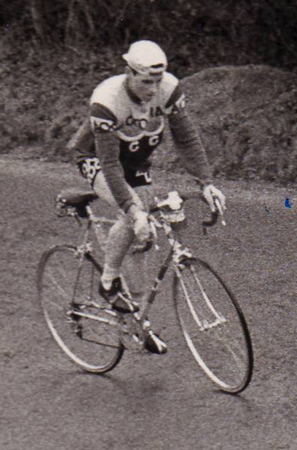
The ‘Shaving of the Legs’ Ritual!
The Actonia junior team, Johnny Rich, Ted Langley, Jim House and myself, had just received our ‘Junior Racing Licences. This meant that we could now enter for road races but, because of our age, the junior races were restricted to no more than 40 miles per race.
Having a Junior Licence also meant that we had to comply with the rules, one of which was ‘Shaving your legs’. To be honest I can’t remember if this was a written rule or an urban myth but we knew all the continental riders had shaved legs and if it was good enough for them—
It was explained to me once that the reasoning behind it was that in the event of an accident it was easier to treat a wound if the leg was bare; also it stopped hairs from drying in the wound, thus reducing the chance of further infection—lecture over!
Only people of our age group will understand this, in those far of days of the early 60’s we didn’t have all the electronic razors and hair removing products that are available today, all we had was the ‘Safety Razor’, a misnomer if ever there was one!
Another true, but nowadays, quite unbelievable fact was that not too many of us had bathrooms. Most working class folk used to live in fairly small rented accommodation which never seemed to have a proper bathroom where you could go to shave your legs in comfort and at your own speed. If you were lucky enough to be in a property which did boast a bathroom there was a good chance that it had to be shared with all the other families who lived in the same house so any bathroom time was limited. We were lucky! One of our team mates, Jim House, came from a middle class family, they still lived in rented accommodation, but it was very posh rented accommodation in Barons Court and in view of the ‘Queens Club’ tennis courts. They had their very own luxurious bathroom, and yes, we could use it for shaving our legs. It got better, not only could we go there to shave our legs but Jim’s mum had an electric razor which she was only to pleased to let us use, what could go wrong?
We, the team, had decided on our training routine for that week, one which we were sure would put us in tip top shape for our first ever road race. Saturday was put aside for a complete overhaul and testing of our bikes and then early to bed, that only left Friday evening to pop around to Jim’s to shave our legs. Unfortunately things are not always as simple as first thought.
We all met up at Jim’s place at about 7-00pm, and were ushered up to the living room for quick ‘hello’ with his parents after which we were let loose on the bathroom. As a precaution we had all taken along our safety razors but were sure they wouldn’t be needed, not with the loan of Jims mum’s electric razor, what could be simpler?
Once in the bathroom we locked the door and removed all our clothing except our underpants, Jim plugged his mum’s razor into the special socket in the wall and away he went. After about ten minutes the razor decided to give up trying, it had removed little or no hair from Jim’s legs and it was beginning to look like we’d been wise in bringing our safety razors along.
After the electric razor had cooled down for a while Jim tried again with about as much success as he achieved the first time, it was no good, the only way left was to use our safety razors. My dad, like most dads, used to shave with a safety razor every day and years of experience allowed his skin to be as smooth and as unblemished as silk. Put the same tool in the hand of a rank amateur who had only been shaving a bit of ‘bum fluff’ from his top lip for a few months and the prospects and the outcome were not good?
Here we were, four very keen young racing cyclists with very hairy legs who needed, desperately, to be less hirsute as quickly as possible.
The bath was filled with around four inches of warm water and we took it in turns to step in, soap up our legs and shave away as best we could.
The amount of blood lost between us that night would have kept a small cottage hospital supplied for a couple of weeks.
We did recover enough to take part in our first race that Sunday and achieved a respectable result, so all was not lost, and what’s a few pints of blood amongst friends?
Posted: Friday 21st August 2020
This article appears in the following categories.
Upcoming Events
Whether you are looking for a gentle social meet up, or a 100-mile ride browse the community’s upcoming events and plan your next weekend outing.
